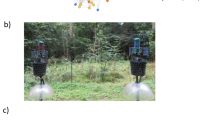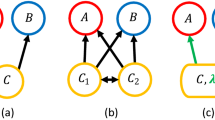Abstract
Prey species that are unprofitable to attack often share conspicuous colours and patterns with other coexisting defended species1,2,3,4,5,6. This phenomenon, termed müllerian mimicry2,3, has long been explained as a consequence of selection on defended prey to adopt a common way of advertising their unprofitability7,8. However, studies using two unpalatable prey types have not always supported this theory9,10,11,12. Here we show, using a system of humans hunting for computer-generated prey, that predators do not always generate strong selection for mimicry when there are two unprofitable prey types. By contrast, we demonstrate that when predators are faced with a range of different prey species, selection on unprofitable prey to resemble one another can be intense. Here the primary selective force is not one in which predators evaluate the profitabilities of distinct prey types independently, but one in which predators learn better to avoid unprofitable phenotypes that share traits distinguishing them from profitable prey13,14. This need to simplify decision making readily facilitates the spread of imperfect mimetic forms from rarity, and suggests that müllerian mimicry is more likely to arise in multispecies communities.
This is a preview of subscription content, access via your institution
Access options
Subscribe to this journal
Receive 51 print issues and online access
$199.00 per year
only $3.90 per issue
Buy this article
- Purchase on Springer Link
- Instant access to full article PDF
Prices may be subject to local taxes which are calculated during checkout



Similar content being viewed by others
References
Bates, H. W. Contributions to an insect fauna of the Amazon valley. Lepidoptera: Heliconidae. Trans. Linn. Soc. Lond. 23, 495–566 (1862)
Müller, F. Über die Vortheile der Mimicry bei Schmetterlingen. Zool. Anz. 1, 54–55 (1878)
Müller, F. Ituna and Thyridia: a remarkable case of mimicry in butterflies. Proc. Entomol. Soc. Lond., xx–xxix (1879)
Sbordoni, V., Bullini, L., Scarpelli, G., Forestiero, S. & Rampini, M. Mimicry in the burnet moth Zygaena ephialtes: population studies and evidence of a Batesian-Müllerian situation. Ecol. Entomol. 4, 83–93 (1979)
Turner, J. R. G. in The Biology of Butterflies (eds Vane-Wright, R. I. & Ackery, P. R.) 141–161 (Academic, London, 1984)
Symula, R., Schulte, R. & Summers, K. Molecular phylogenetic evidence for a mimetic radiation in Peruvian poison frogs supports a Müllerian mimicry hypothesis. Proc. R. Soc. Lond. B 268, 2415–2421 (2001)
Poulton, E. B. The Colours of Animals: Their Meaning and Use Especially Considered in the Case of Insects (Keegan Paul, Trench, Trubner & Co., London, 1890)
Mallet, J. & Joron, M. Evolution of diversity in warning colour and mimicry: Polymorphisms, shifting balance, and speciation. Annu. Rev. Ecol. Syst. 30, 201–233 (1999)
Greenwood, J. J. D., Wood, E. M. & Batchelor, S. Apostatic selection of distasteful prey. Heredity 47, 27–34 (1981)
Greenwood, J. J. D., Cotton, P. A. & Wilson, D. M. Frequency-dependent selection on aposematic prey—some experiments. Biol. J. Linn. Soc. 36, 213–226 (1989)
Lindström, L., Alatalo, R. V., Lyytinen, A. & Mappes, J. Strong antiapostatic selection against novel rare aposematic prey. Proc. Natl Acad. Sci. USA 98, 9181–9184 (2001)
Rowe, C., Lindström, L. & Lyytinen, A. The importance of pattern similarity between Müllerian mimics in predator avoidance learning. Proc. R. Soc. Lond. B 271, 407–413 (2004)
MacDougall, A. & Dawkins, M. S. Predator discrimination error and the benefits of Müllerian mimicry. Anim. Behav. 55, 1281–1288 (1998)
Ruxton, G. D. Sheep in wolves' clothing. Nature 394, 833–834 (1998)
Benson, W. W. Natural selection for Müllerian mimicry in Heliconius erato in Costa Rica. Science 176, 936–939 (1972)
Mallet, J. & Barton, N. H. Strong natural selection in a warning color hybrid zone. Evolution 43, 421–431 (1989)
Kapan, D. D. Three-butterfly system provides a field test of Müllerian mimicry. Nature 409, 338–340 (2001)
Mallet, J. & Gilbert, L. E. Why are there so many mimicry rings—correlations between habitat, behavior and mimicry in Heliconius butterflies. Biol. J. Linn. Soc. 55, 159–180 (1995)
Mallet, J. Mimicry: An interface between psychology and evolution. Proc. Natl Acad. Sci. USA 98, 8928–8930 (2001)
Shettleworth, S. J. Cognition, Evolution, and Behavior (Oxford Univ. Press, New York, 1998)
Shepard, R. N., Hovland, C. I. & Jenkins, H. M. Learning and memorization of classifications. Psychol. Monogr. 75(13), 1–42 (1961)
Pearce, J. M. in Animal Learning and Cognition (ed. Mackintosh, N. J.) 110–134 (Academic, San Diego, 1994)
Fisher, R. A. The Genetical Theory of Natural Selection (Oxford Univ. Press, Oxford, 1930)
Glanville, P. W. & Allen, J. A. Protective polymorphism in populations of computer-simulated moth-like prey. Oikos 80, 565–571 (1997)
Götmark, F. & Hohlfält, A. Bright male plumage and predation risk in passerine birds: are males easier to detect than females? Oikos 74, 475–484 (1995)
Sherratt, T. N. & Beatty, C. D. The evolution of warning signals as reliable indicators of prey defense. Am. Nat. 162, 377–389 (2003)
Miller, G. A. The magical number seven, plus or minus two: some limits on our capacity for processing information. Psychol. Rev. 63, 81–97 (1956)
Dukas, R. Behavioural and ecological consequences of limited attention. Philos. Trans. R. Soc. Lond. B 357, 1539–1548 (2002)
Beatty, C. D., Bain, R. S. & Sherratt, T. N. The evolution of aggregation in profitable and unprofitable prey. Anim. Behav. (submitted)
Alatalo, R. V. & Mappes, J. Tracking the evolution of warning signals. Nature 382, 708–710 (1996)
Acknowledgements
C.D.B. and K.B. collected the data, whereas T.N.S. helped design the experiments and developed the computer program. We thank F. Batiste, A. Rashed, G. Ruxton, M. Speed, H. Van Gossum and D. Wilkinson for comments on our manuscript. The research was approved by the Carleton University Research Ethics Committee and conducted according to the guidelines set out in the Tri-Council Policy Statement on Ethical Conduct for Research Involving Humans. The work was supported by grants to T.N.S. from NSERC, the Canada Foundation for Innovation and the Ontario Innovation Trust.
Author information
Authors and Affiliations
Corresponding author
Ethics declarations
Competing interests
The authors declare that they have no competing financial interests.
Supplementary information
Supplementary Figure 1
Screen shot of our computer-generated foraging arena. (DOC 84 kb)
Supplementary Figure 2
Probability of attack related to encounter sequence in experiments 3a-c and 4a-c. (DOC 40 kb)
Supplementary Figure 3
Mean total scores of our predators and their standard errors for experiments 2-5. (DOC 34 kb)
Supplementary Table
A more detailed summary of the results of experiment 1. (DOC 50 kb)
Rights and permissions
About this article
Cite this article
Beatty, C., Beirinckx, K. & Sherratt, T. The evolution of müllerian mimicry in multispecies communities. Nature 431, 63–66 (2004). https://doi.org/10.1038/nature02818
Received:
Accepted:
Issue Date:
DOI: https://doi.org/10.1038/nature02818
This article is cited by
-
Predator selection on phenotypic variability of cryptic and aposematic moths
Nature Communications (2024)
-
Body size in Batesian mimicry
Evolutionary Ecology (2023)
-
Assessing Müllerian mimicry in North American bumble bees using human perception
Scientific Reports (2022)
-
Habitat generalist species constrain the diversity of mimicry rings in heterogeneous habitats
Scientific Reports (2021)
-
Differential Bird Responses to Colour Morphs of an Aposematic Leaf Beetle may Affect Variation in Morph Frequencies in Polymorphic Prey Populations
Evolutionary Biology (2019)
Comments
By submitting a comment you agree to abide by our Terms and Community Guidelines. If you find something abusive or that does not comply with our terms or guidelines please flag it as inappropriate.



